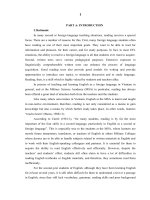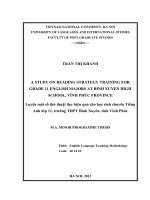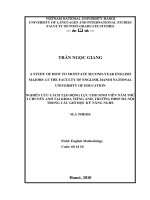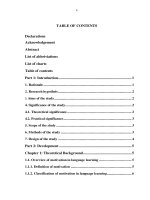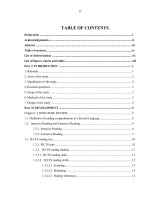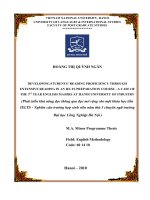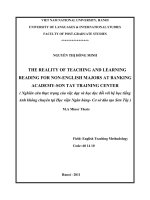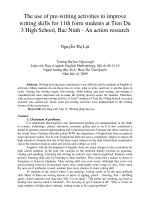The use of video assisted instruction for second yeah english majors at the peoples security academy in listening class an action research
Bạn đang xem bản rút gọn của tài liệu. Xem và tải ngay bản đầy đủ của tài liệu tại đây (1.64 MB, 100 trang )
VIETNAM NATIONAL UNIVERSITY, HANOI
College of Foreign Languages
Post-Graduate DEPARTMENT
------ ------
NG NGHIấM THU NGA
The Use of Video-Assisted Instruction for Second-Year
English-Majors at THE Peoples Security Academy
in Listening Class An Action Research
(Nghiên cứu hành động về tác động của việc dạy học có
sự hỗ trợ của băng hình đối với sinh viên chuyên ngữ năm
thứ hai tại Học viện An ninh nhân dân trong giờ học nghe)
Field :
English Methodology
Code:
60 14 10
Course:
K15
MA.Minor Thesis
Supervisor:
TUN MINH, Ph.D
Hanoi, September 2009
iv
TABLE OF CONTENTS
Acknowledgements .................................................................................................................... i
Abstract......................................................................................................................................ii
Table of contents ...................................................................................................................... iv
List of figures, tables and charts............................................................................................vii
List of Abbreviations ............................................................................................................ viii
Chapter 1: Introduction ........................................................................................................... 1
1.1. Rationale of the study ...................................................................................................... 1
1.2. Significance of the study.................................................................................................. 2
1.3. Aims of the study ............................................................................................................. 3
1.4. Scope of the study ............................................................................................................ 3
1.5. Design of the study .......................................................................................................... 4
Chapter 2: Literature Review ................................................................................................. 6
2.1. Definition and benefits of using video in language classroom ...................................... 7
2.2. Theories of listening comprehension ........................................................................... 10
2.2.1. Introduction and definitions of listening comprehension ..................................... 10
2.2.2. Listening processes ............................................................................................... 11
2.2.3. Listening in language learning and teaching ........................................................ 13
2.3. The application of video in language teaching ............................................................ 14
2.4. Previous studies and fitness of the present study into the field ................................... 16
Chapter 3: Methodology ........................................................................................................ 18
3.1. The context of teaching and learning listening skills to English majors in the PSA ..... 18
3.2. Participants..................................................................................................................... 19
3.2.1. Students .................................................................................................................... 19
3.2.2. Teachers ................................................................................................................... 20
3.3. Problem formulation ...................................................................................................... 21
3.4. Classroom setting ........................................................................................................... 23
v
3.5. Instruments..................................................................................................................... 24
3.5.1. Interviews................................................................................................................. 24
3.5.2. Questionnaires ......................................................................................................... 24
3.5.3. Classroom observation checklist ............................................................................. 25
3.5.4. Achievement tests .................................................................................................... 26
3.6. Teaching procedure........................................................................................................ 27
3.7. A description of the Research Process ........................................................................... 28
3.8. Plan of action ................................................................................................................. 29
3.9. Data collection procedure .............................................................................................. 31
3.10. Data analysis procedure ............................................................................................... 32
Chapter 4: Results and Evaluation ....................................................................................... 34
4.1. Teachers’ perception and evaluation toward students’ listening competence and
video-assisted instruction .......................................................................................................... 34
4.1.1. Teachers’ evaluation toward students’ listening competence .................................. 34
4.1.2. Teachers’ perception of video-assisted instruction .................................................. 34
4.1.3. Teachers’ evaluation toward video-assisted instruction .......................................... 35
4.1.4. Teachers’ perception of difficulties in teaching listening using video .................... 36
4.2. Reflection on the implementation of action plan in the first half of the second
semester .................................................................................................................................... 37
4.2.1. Students’ performance in the first half of the second semester ............................... 37
4.2.2. Teacher-researcher’s self-evaluation toward the teaching process and students’
attitude in the first half of the second semester ........................................................................ 39
4.3. Modifications .............................................................................................................. 40
4.4. Final reflection and reporting the outcomes .................................................................. 42
4.4.1. Students’ initial assessment on their listening skill ................................................. 42
4.4.2. Changes in students’ attitude toward learning in video-assisted instruction ........... 43
4.4.3. Students’ assessment on the role of video-assisted instruction ............................... 45
4.4.4. Changes in students’ perceived learning and performance ..................................... 46
vi
Chapter 5: Discussion and Conclusion ................................................................................. 50
5.1. Major findings and discussion of the research............................................................. 50
5.2. Limitations of the research .......................................................................................... 52
5.3. Suggestion for further studies ...................................................................................... 53
References ................................................................................................................................ 54
Appendices ................................................................................................................................. I
Appendix 1: Interviews for teachers ........................................................................................... I
Appendix 2: Questionnaires for students .................................................................................. III
Appendix 3: Findings from interviews .....................................................................................XI
Appendix 4: Classroom Observation Checklist ..................................................................... XIX
Appendix 5: Sample of lesson plan using video ................................................................. XXIII
vii
LIST OF FIGURES, TABLES AND CHARTS
Tables
Table 1: Classroom observation checklist before and after mid-term test
Figures
Figure 1: Comparison between the listening result of the first semester and that of mid-term
test in the second semester
Figure 2: Most favourite video programs
Figure 3: Most favourite video-assisted classroom activities
Figure 4: Change in percentage of students’ retention after using video
Figure 5: Change in percentage of students’ comprehension after using video
Pie charts
Chart 1: Final listening mark of second-year English majors in the first semester
Chart 2: Result of mid-term listening test using video
Chart 3: Students’ assessment on the importance of video-assisted instruction
Chart 4: Students' assessment on the necessity of video-assisted instruction
Chart 5: Result of final test of second semester
viii
LIST OF ABBREVIATIONS
The PSA: The People’s Security Academy
L1: first language
L2: second language
HULIS: Hanoi University of Language and International Studies
IT: Information Technology
Ss: Students
ESP: English for special purpose
1
CHAPTER 1: INTRODUCTION
1.1. Rationale of the study
Technology is becoming more and more prevalent in today’s classrooms in
Vietnam and a part of the classroom as an instructional and research aid for teachers and
students. However, there are not many studies on the effect that technology such as video
or Internet in the classroom has on students’ attitudes towards learning. There are a lesser
number of studies on the effect of video to support teaching and learning listening skill in
the classroom. Many questions have arisen from the use of technology in general and
video-assisted instruction in particular in listening class but so far without satisfactory
answers. Do students’ attitudes about learning change when using video in the classroom?
Does it motivate students to learn more? Does it affect a student’s academic listening
comprehension in the classroom? What impacts do technology in general and video in
particular have on a student, when they view the challenges of a listening lesson? How
should video-assisted instruction be designed and used in listening class?
In the process of acquiring foreign language in the light of Communicative
Approach, listening seems to be the most challenging for learners at the People’s Security
Academy. Second language (L2) listening comprehension is a complex process, crucial in
the development of second language competence. Knowing the context of a listening text
and the purpose for listening greatly reduces the burden of comprehension. However,
students still often have difficulty in comprehension and lack concentration as well as
attraction in listening class. They try hard to hear every single word, to interpret any
minutiae of spoken English and totally collapse at the end. Such a fact shows the necessity
and an urgency to provide students with a new and effective listening setting.
Video materials have long been used in the classroom as an important tool for
teaching listening and speaking in the world. In recent years, combining video with IT –
information technology (computer-based streaming audio and video) – is being developed.
It allows teachers to transport virtually the target language environment into the classroom
so that live or prerecorded news, music, sports from all over the world can be viewed by
students in real time. The main advantage of using video as a technology for language
2
teaching is considered to be its ability to present and immerse learners into complete
communicative situations (Lonergan, 1984). Another greatest advantage is the ability of
video to cover non-verbal aspects of communication and its cross-cultural comparison
potential (Stempleski & Tomalin, 1990).
It may be said that video is the best means of demonstrating native speakers’
natural fluent communication and their natural behavior in the process of communication.
Learners can not only hear how native speakers speak, they can observe and learn how
they behave when speaking. It also gives materials for oral communication because
learners may brainstorm and discuss what they have seen and heard, role-play it, enact it,
develop and transform it in their own speaking, etc. They can do that in pair intercourse,
small group communication, whole-class discussions actively involving everyone present
in the classroom. The observed native-speakers’ behavior may be imitated in such
communication so that cultural components of communicative competence are acquired
together with its linguistic components.
In this study, the researcher would like to investigate the use of video-assisted
instruction for second-year English majors at the PSA in listening class. This study will
describe an action research project for video-assisted instruction as well as collaborative
teaching and learning. It also gives an account of how the teacher-researcher reflected on
her teaching and modified her teaching methods, followed by a description of the changes
in students’ listening comprehension and their attitudes toward learning listening skill
compared with traditional audio-only version.
1.2. Significance of the study
Although listening skill has always been given a significant position in language
teaching, the questions of how to teach and learn listening skill effectively often pose great
problems to both teachers and students. This study primarily explores how the use of
video-assisted instruction affects second-year English majors at the PSA in listening class.
It, therefore, serves as a valuable resource for teachers to gain a deep insight into the
practice of video-assisted instruction at the target university. More importantly, an
inventory of video-assisted instruction as well as practical evaluation and modifications in
teaching methods aims at assisting teachers to effectively teach listening skill to English
majors. Placing second-year English majors at the center of analysis, the study intends to
3
help the target population to succeed in improving listening comprehension. On a larger
scale, the study can be beneficial to teachers of English and English majors at other
universities, who may undergo the same context of teaching and learning this skill.
1.3. Aims of the study
The purpose of this study is to investigate the effect of video-assisted instruction on
enhancing second-year English-major students’ learning at the PSA in listening class.
Based on the findings, an action plan is implemented to evaluate the effectiveness of this
instruction as well as the students’ improvement in their listening comprehension
To achieve this purpose of the study, the following research questions are
addressed:
Research Question 1: How does video-assisted instruction affect students’ learning (i.e
comprehension and retention) in listening lessons?
Research Question 2: Does the use of video in teaching listening change the attitude of
second-year English-majors toward learning listening skill?
Research Question 3: Do students’ learning (i.e comprehension and retention) and
motivation (i.e., attention and satisfaction) in video-assisted instruction differ from that
in traditional audio-only instruction?
Research Question 4: Does the use of video in listening class improve students’ listening
competence?
1.4. Scope of the study
The research limits its scope to listening skill and to its participants of second-year
English-majors of intermediate level at the People’s Security Academy.
Of four skills of language teaching, I choose listening skill to deal with as I have
tried out some listening lessons using video and I have found that listening in the
classroom derived from the use of video is very interesting and hopeful. Also, I realize
changes in my students’ attitudes toward learning listening skill. Furthermore, this issue in
language teaching has not been exploited sufficiently so far.
The choice of participants is simply a matter of convenience as I am teaching
listening for second-year English-majors at the People’s Security Academy at the moment.
4
Personally, I suppose that students at this level are more suitable for the application of this
teaching method. Hence, audio-visual lessons are very demanding to most students, and
require them relevant background knowledge to comprehend.
The materials for my listening lessons are collected from several sources such as
movies, films, news, documentaries or video clips downloaded from the Internet. However,
as Underwood (1989) pointed out that what determines the difficulty of a teaching material
is not just the material itself but also what the students are asked to do with it, the selection
of authentic materials is still limited due to several reasons. Firstly, the preparation for the
lessons is very time-consuming. Secondly, teachers always find it difficult to design
appropriate exercises and tasks for their students. Finally, not all teachers are competent in
IT (information technology) so that they can cut, record, edit the video and apply it into
their listening lessons.
1.5. Design of the study
The thesis is divided into six parts:
Chapter 1 introduces the research problem and rationale of the study. It also states
the significance, aims, scope and methods of the study.
Chapter 2 not only provides an overview of background to the study, including key
concepts and theories relating to the research topic but also discusses previous studies of
this field to reveal the research gap which needs filling. In addition, the chapter enlarges
upon the context of teaching and learning listening skill at the PSA and exposes the
problem formulation.
Chapter 3 presents the methodology applied in the study including participants,
instrumentation, research process and plan of action. In addition, the procedure of data
collection is also embraced.
Chapter 4 presents the results of the research and data analysis, from which major
findings are revealed and discussed. Additionally, the reflection of the action plan is
implemented.
Chapter 5 reviews the findings and indicates some limitations of the study. Also,
discussion and suggestions for further study are put forward.
5
Conclusion
In summary, the chapter has dealt with the rationale, research problem, purposes,
scope and methods of the study. An overview of the thesis design ends this chapter. With
all the contents above, the chapter acts as a guideline for the development of the later parts
of the study.
6
CHAPTER 2: LITERATURE REVIEW
Introduction
The importance of context-based learning using real world context for enhancing
learning outcomes has been emphasized by socio-cultural learning theorists (Merriam &
Caffarella, 1999). The dominant idea of socio-cultural learning theory is that learning is
not something that happens in isolation, or is just inside the head, but is shaped by the
context, culture, and tools in the learning situation (Merriam & Caffarella, 1999). It is
believed that real world contexts in which there are social relationships, tools, and engaged
experiences, can make the best learning environments (Lave, 1996). This idea of sociocultural learning is also based on Vygotsky’s thought that all human activities take place in
a cultural context with many levels of interactions, shared beliefs, values, knowledge,
skills, structured relationships, and symbol systems (Vygotsky, 1978). These interactions
and activities are mediated through the use of tools, either technical or psychological.
Among various tools, the use of instructional technology has been rapidly adopted for the
enhancement of interactions and activities.
Of the various technologies currently available, video technology is suitable for
context-based learning because it can convey the information or knowledge in a more
interesting way. In addition, compared with expository materials, stories in video can help
learners easily understand and remember the content (Jonassen, Peck, & Wilson, 1999).
Anticipating the benefits that a video recorder brings into the classroom, more language
teachers are designing video tape materials with the classroom exploitation in mind. Four
or five minutes of video tape material can easily provide enough stimulating input for one
hour’s teaching.
This chapter gives an overview of the literature in which key concepts, theories and
previous studies in the field are presented. In addition, research gaps are exposed to fit in
with the present study.
2.1. Definition and benefits of using video in language classroom
7
According to Longergan (1994), the term “video” has two meanings. For some, it
means no more than replaying television program on a video recorder, for viewing in class
or private study. For others, it implies the use of video camera in class to record and play
back to learners their activities and achievements in a foreign language. Longergan defines
the term “video film” as a photographic process, involving the effects of light and
chemicals on sensitive paper. He also categorized the sources of video materials used in
language teaching as follow:
-
video recordings of language-teaching broadcasts and films;
-
video recordings of domestic television broadcasts, such as comedy programs
and new programs;
-
video recordings of specialist films and television programs, such as
documentaries produced by industry, or educational programs;
-
video language-teaching materials made for the classroom rather than for public
transmission as broadcasts;
-
self-made video films, involving the teachers and learners.
An important attribute of video is the ability to use both auditory and visual symbol
systems (Baggett, 1984). It appears that when audio and visual systems are presented
together, each source provides additional and complementary information that retains some
of the characteristics of the symbol system of origin. Baggett (1984) observed that
information obtained visually was more memorable, on the basis of her finding that
summaries written a week after viewing a movie were judged to be more complete than
those written a week after listening to the audio-only version. Kozma (1991) also
supported the fact that the visual component is memorable. He argued that simultaneous
processing of auditory and visual information may aid learning. In addition, video might be
efficient for learning complex skills because it can expose learners to problems, equipment,
and events that cannot be easily demonstrated.
According to Dusenbury, Hansen, & Giles (2003), video-assisted instruction has
the benefits of standardizing messages, so it might be able to increase the fidelity of
implementing instruction. The M.A thesis conducted by Nguyen M., T. (2005) also
summarized general benefits of using video in language classroom as follow:
8
It is quite easy to notice the compelling power of video in the classroom, a
power that is even enhanced by concentration on short sequences. Video, in
other words, stimulates students’ motivation, and maintains their interest and
concentration better than sound-only learning environment.
Using video in language teaching can enhance students’ understanding and
retention of information. It brings students also kinds of situation, with full
contextual back-up.
Video is used to help enhance the meaning of message trying to be conveyed by
the speakers through the use of paralinguistic cues. In addition, it allows
students to see body language and speech rhythm in second language discourse
through the use of authentic language and speed of speech in various situations.
Video is a window on English-language culture.
Video can be used as a stimulus or input for discussion, for writing assignment,
projects or the study of other subjects.
Video, as a moving picture book, gives access to things, places, people, events
and behaviour, regardless of the language used.
Using video in language teaching allows differentiation of teaching and
learning according to the students’ abilities, learning styles and personalities.
Teaching with video can widen the range of activities in the classroom.
The students dealing with video in their learning improve a range of social
skills, including communication, negotiation, decision-making and problemsolving.
He also found out that the video course not only teaches English through video but
gets students to use the English they have learned in talking about the video. In addition,
using video creates a great number of tasks and activities that stimulate communication
and particular spoken language among students.
In the book titled Video in Action, Stempleski & Tomalin (1990) are convinced
that the introduction of a moving picture component as a language teaching aid is a crucial
addition to the teacher’s resources.
9
First of all, through motivation. Children and adults feel their interest quicken when
language is experienced in a lively way through television and video. Using a video
sequence in class is the best thing to experiencing the sequence in real life.
Second, through communication. Teachers have observed how a video sequence
used in class makes students more ready to communicate in the target language.
Third, through non-verbal aspects of communication. Video allows us to see
gestures, expression, posture, dress, and surroundings – the setting of communication and
to freeze any moments to study the non-verbal communication in detail.
Finally, through cross-cultural comparison. Observing differences in cultural
behaviour is not only suitable training for operating successfully in a different community.
It is also a rich resource for communication in the language classroom.
To sum up, the use of video can make language more accessible to learners by:
making it easier to integrate and contextualize listening, speaking and
pronunciation, reading and writing activities
motivating learners and helping them in their efforts to use the language naturally
in their own lives by seeing how the characters succeed in communicating with
native speakers and getting things done in their everyday activities
bringing native speakers into the classroom (on video), providing additional models
for pronunciation, intonation, and rhythm besides that of the teacher
raising learners’ awareness of non-verbal aspects of communication
increasing listening comprehension: paralinguistic features (facial expression, body
language, context, setting…) help learners comprehend more than from listening to
audio tape only
stimulating learner interaction and communication with co-learners as they discuss
the video itself or ways in which it relates to their lives and experiences
raising cross-cultural awareness: learners enjoy observing similarities and
differences between the behavior of the characters in a video clip and that of their
own families and friends.
2.2. Theories of listening comprehension
10
2.2.1. Introduction and definitions of listening comprehension
Research has demonstrated that adults spend 40-50% of communication time
listening (Gilman & Moody 1984), but the importance of listening in language learning has
only been recognized relatively recently (Oxford, 1993). Since the role of listening
comprehension in language learning was taken for granted, it merited little research and
pedagogical attention. Although listening played an important role in audio-lingual
methods, students only listened to repeat and develop a better pronunciation (for speaking).
The role of listening has been considered as a tool for understanding and a key factor in
facilitating language learning. Listening has emerged as an important component in the
process of second language acquisition (Feyten, 1991).
Listening is an invisible mental process, making it difficult to describe. Listeners
must discriminate between sounds, understand vocabulary and grammatical structures,
interpret stress and intention, retain and interpret this within the immediate as well as the
larger socio-cultural context of the utterance (Wipf, 1984). Rost (2002) defines listening, in
its broadest sense, as a process of receiving what the speaker actually says (receptive
orientation); constructing and representing meaning (constructive orientation); negotiating
meaning with the speaker and responding (collaborative orientation); and, creating
meaning through involvement, imagination and empathy (transformative orientation).
Listening is a complex, active process of interpretation, in which listeners match what they
hear with what they already know.
According to Underwood (1989), listening is the activity of paying attention to and
trying to get meaning from something we hear. She also emphasized: “To listen
successfully to spoken language, we need to be able to work out what speakers mean when
they use particular words in particular ways on particular occasions, not simple to
understand the words themselves” (Underwood, 1989:1). The author called for listening
beyond word level, and stressed the necessity for associating utterances within their
context as a prerequisite for successful comprehension.
Specifically, listening theory is about an active process in which individuals focus
on selected aspects of aural input, construct meaning form passages, and relate what they
hear to existing knowledge (O’Malley, Chamot, Kupper, 1989:418). During the process of
interpreting aural input, listeners extensively deploy both linguistic knowledge (phonology,
11
lexis, syntax, semantics and discourse) and non-linguistic knowledge (knowledge about the
topic and about the context, and general knowledge about the world and real life).
Rivers & Temperly (1978:63) defined listening as a complex operation integrating
the distinct components of perception and linguistic knowledge. It is not a passive but an
active process of constructing a message from a stream of sound with what one knows of
the phonological, semantic, and syntactic potentialities of the language.
All in all, listening has been conceptualized in different ways and from different
points of view. However, the role of context-based listening is also found and highlighted
in many definitions.
2.2.2. Listening processes
There are two distinct processes involved in listening comprehension. Listeners use
'top-down' processes when they use prior knowledge to understand the meaning of a
message. Prior knowledge can be knowledge of the topic, the listening context, the texttype, the culture or other information stored in long-term memory as schemata (typical
sequences or common situations around which world knowledge is organized). Listeners
use content words and contextual clues to form hypotheses in an exploratory fashion. On
the other hand, listeners also use 'bottom-up' processes when they use linguistic knowledge
to understand the meaning of a message. They build meaning from lower level sounds to
words to grammatical relationships to lexical meanings in order to arrive at the final
message.
Listening comprehension is not either top-down or bottom-up processing, but an
interactive, interpretive process where listeners use both prior knowledge and linguistic
knowledge in understanding messages. The degree to which listeners use the one process
or the other will depend on their knowledge of the language, familiarity with the topic or
the purpose for listening. For example, listening for gist involves primarily top-down
processing, whereas listening for specific information, as in a weather broadcast, involves
primarily bottom-up processing to comprehend all the desired details.
On one hand, research from cognitive psychology has shown that listening
comprehension is more than extracting meaning from incoming speech. It is a process of
12
matching speech with what listeners already know about the topic. Therefore, when
listeners know the context of a text or an utterance, the process is facilitated considerably
because listeners can activate prior knowledge and make the appropriate inferences
essential to comprehending the message (Byrnes, 1984). Therefore, teachers need to help
students organize their thoughts, to activate appropriate background knowledge for
understanding and to make predictions, to prepare for listening. This significantly reduces
the burden of comprehension for the listener.
On the other hand, listeners do not pay attention to everything; they listen
selectively, according to the purpose of the task. This, in turn, determines the type of
listening required and the way in which listeners will approach a task. (Richards, 1990)
differentiates between an interactional and a transactional purpose for communication.
Interactional use of language is socially oriented, existing largely to satisfy the social needs
of the participants; e.g., small talk and casual conversations. Therefore, interactional
listening is highly contextualized and two-way, involving interaction with a speaker. A
transactional use of language, on the other hand, is more message-oriented and is used
primarily to communicate information; e.g., news broadcasts and lectures. In contrast with
interactional listening, transactional listening requires accurate comprehension of a
message with no opportunity for clarification with a speaker (one-way listening). Knowing
the communicative purpose of a text or utterance will help the listener determine what to
listen for and, therefore, which processes to activate. As with the advantages of knowing
the context, knowing the purpose for listening also greatly reduces the burden of
comprehension since listeners know that they need to listen for something very specific,
instead of trying to understand every word.
In short, second language (L2) listening comprehension is a complex process,
crucial in the development of second language competence. Listeners may use all of the
above processes to comprehend. Guiding students through the process of listening not only
provides them with the knowledge by which they can successfully complete a listening
task; it also motivates them and puts them in control of their learning. Therefore, teachers
can help students develop their listening comprehension through these processes by
designing appropriate listening instructions and activities.
2.2.3. Listening in language learning and teaching
13
Listening comprehension as a separate component of language learning and
instruction came into its own only after long and significant debate regarding its validity. A
large volume of research has demonstrated the critical role of input, and particular
“comprehensible input” in language acquisition, underlining the primacy of the role played
by listening comprehension in second language teaching.
Until recently, listening comprehension activity in foreign or second language
classrooms was limited to testing listening comprehension. The underlying rationale was
that if students are successfully learning the target language, they should automatically be
able to decode the aural version of structures and vocabulary they learn in their textbooks.
Success at this decoding was typically measured by correct responses to WH (information)
questions. Responses to such questions tagged successful retrieval of information from an
aural text. Knowledge of target language syntax and lexis was deemed sufficient to enable
this retrieval and was ultimately the way how students were tested. Listening is now
treated as a much more complex activity and one that is the cornerstone of language
acquisition (Krashen, 1994).
Recognition of listening's critical role in the language acquisition process has
greatly influenced contemporary language teaching practice. The view that listening is an
active and interactive process has, for example, cast the learner in a role other than the
passive receiver of aural input (Rost, 1993). Classroom emphasis is now on aural intake
through active negotiation of meaning. In face to face interaction, the listener, not just the
speaker, engages in the active making of meaning. It is believed that this mutual
negotiation of meaning between speakers activates the cognitive and socio-cognitive
processes necessary for language acquisition to occur (Breen and Candlin, 1980; Pica and
Doughty, 1985). In short, listening has been recast as an activity central to the L2
acquisition process (Dunkle, 1991; Krashen, 1981; Rost, 1993), and a skill integral to
overall communicative competence (Brown, 1994b; Savignon, 1991).
Listeners use meta-cognitive, cognitive and socio-affective strategies to facilitate
comprehension and to make their learning more effective. Meta-cognitive strategies are
important because they oversee, regulate or direct the language learning process. Cognitive
strategies manipulate the material to be learned or apply a specific technique to a listening
task. Socio-affective strategies describe the techniques listeners use to collaborate with
others, to verify understanding or to lower anxiety. Research shows that skilled listeners
14
use more metacognitive strategies than their less-skilled counterparts (O'Malley & Chamot,
1990, Vandergrift, 1997a).When listeners know how to
analyse the requirements of a listening task;
activate the appropriate listening processes required;
make appropriate predictions;
monitor their comprehension; and
evaluate the success of their approach,
they are using metacognitive knowledge for successful listening comprehension, which is
critical to the development of self-regulated learning.
2.3. The application of video in language teaching
The application of video in the classroom has offered exciting possibilities for
language teaching and learning so far. There have been a lot of books studying and
presenting techniques for using video in the classroom. Teaching with video equipment
does not imply that an entirely new methodology should be taken over but relate to the
teacher’s own professional experience and local conditions.
In his book titled “Video in language teaching”, Lonergan (1984) introduced
teachers and teacher trainers to some general principles concerning the use of simple video
equipment in the language classroom. With these insights into teaching with video,
teachers can develop their own techniques and language-learning materials. However, the
book only limits to simple video equipment: basically, a camera and video recorder. Also,
there is a limit to what new technology can offer the language learners of the future.
Therefore, as he pointed out: “the teacher should analyse what the technology can offer;
apply sound pedagogical principles to that, and adapt and use the technology for his or her
own specific language-teaching situation”.
Another book discussing about video techniques is Video in Action by Stempleski
& Tomalin (1990). It provides a full-scale collection of recipes for using video in class.
Once you have chosen a sequence of video, you can browse through recipes until you find
a suitable one. This book not only deals with equipment and the ways how to run a video
library but also answers a number of questions about video and its use.
15
The application of ICT in general and video in particular in Vietnam has
considerably enriched the variety of methods, resources and a range of activities for
learning languages. On one hand, it gives more opportunities for communication between
peer learners. On the other hand, it breaks the routine of learning words or grammar
patterns and adds to the positive attitude of both learners and teachers. Video has gained
popularity in language-teaching classroom in recent years in Vietnam. Several languageteaching centers, schools and university use teaching materials aided with audio-video.
However, using video-assisted teaching materials is very time-consuming and expensive
due to the need of facilities for study. Only well-equipped schools or language centers can
meet the requirements of the course using video.
The situation of video application in universities under Ministry of Public Security
is rather gloomy. Students are not interested in learning English as it is not a major subject.
Only the PSA and the People’s Police Academy have English majors. The equipment and
facilities needed for language learning and teaching, therefore, is relatively sufficient. For
example, the laboratories are equipped with cabins and headphones, computers, projectors
and even multi-media projector as well as Internet access, which facilitate the teaching of
listening skill using video a lot. Students can view online video clips, films, documentaries
and news. In other words, both teachers and students have a lot of opportunities to
approach English learning and teaching in a new and effective way. However, the
investment of building this kind of laboratories needs a large amount of money. Each
university can afford to have one or two models like these. Furthermore, not all teachers of
English are able to deal with video edition like cutting, recording, editing or making a
video clip suitable for their listening lessons. This kind of work requires teachers to master
computer software. ICT competence is always Vietnamese teachers’ weakness which
becomes a hindrance for the application of technology in general and video in particular in
their teaching. Obviously, the application of video in teaching listening skill is not
satisfactory.
In summary, the application of video in language teaching has been clarified and
closely linked with the process of designing questionnaires in order to investigate the effect
of video-assisted instruction on second-year English majors at the PSA. It is, therefore,
necessary to study the context of teaching listening skill to English majors at the PSA.
16
2.4. Previous studies and fitness of the present study into the field
In the context of Vietnam, especially in HULIS, there have been few studies on the
use of video and on the effect of video-assisted instruction on students’ listening
competence. Nguyen, M.T (2005) conducted a study titled “Design a listening and
speaking syllabus using video for English language non-majors at pre-intermediate level“.
In his study, he mainly built up a suitable syllabus with audio-visual aids to improve
students’ listening and speaking skills. He also embraced fundamental techniques and
video activities in language classroom. However, the syllabus he designed limited its scope
to non-English-majors at pre-intermediate level with the purpose of improving listening
and speaking skills. The study was conducted on students of the above level in May
School, at 36 Ly Thai To, Hanoi, where most teaching materials were aided with audiovideo. The method used in this study is qualitative including comments, remarks,
comparisons and suggestions based on factual research, observation, experience and
discussion. Although the findings and syllabus were valuable and practical in the context
of language teaching and learning in Vietnam, there are still several limitations in this
study. Firstly, the subjects of the study were students from a school – a foreign languages
center, who were totally different from university students in terms of classroom setting,
English proficiency, linguistic competence as well as materials and teaching method
applied by teachers. Secondly, the reliability of data collected was not sufficient as he did
not present his questionnaires in the thesis, which might fail to depict the need analysis.
Another thesis conducted by Bach, T., H., Y., (2009) studied on the effectiveness of
video-assisted instruction on teaching listening for non-English-majors at Phuong Dong
university. This is an experimental research in which the participants were divided into two
groups: the control (A) and the treatment (B). Both of the classes were second-year non
English major students. The results from pre-test showed that the listening competence in
class A was better than class B. However, after one semester applying video-assisted
instruction to class B, the students’ listening competence was better than the control group
who were not taught with video materials. The only limitation of this study is its
instrumentation. The only instruments are pre-test and post-test whose validity and
reliability are not high enough. It is better if included other instruments such as journals or
observation checklist.
17
To sum up, thanks to the aforementioned research gap, the researcher feels an urge
to conduct an investigation on the use of video-assisted instruction on English majors at the
PSA in listening class.
Conclusion
This chapter not only provides an overview of background to the study, including
key concepts and theories relating to the research topic but also discusses previous studies
of this field to reveal the research gap which needs filling. These issues will be referred
back in the next chapters.
18
CHAPTER 3: METHODOLOGY
Introduction
Chapter 3 presents the methodology applied in the study including the context of
teaching and learning listening skill to English majors, problem formulation, participants,
plan of action, instrumentation and the procedure of data collection and data analysis. In
addition, it provides justifications for the selection of research methods.
3.1. The context of teaching and learning listening skill to English majors in the PSA
Unlike other universities under Ministry of Public Security, the PSA has two kinds
of students: non-English-majors and English-majors. Therefore, the aims of the two
curriculums are different. Non-English-major students are expected to be fluent in English
communication meanwhile it is compulsory for English-major students to master English
both spoken and written in order to meet the needs of their later work. Both non-Englishmajor and English-major courses in the university last five years.
The learning materials for English-major students in the first two years are
designed by teachers of English from Foreign Languages Department. A large number of
students come from different parts and provinces of the country where English is belittled,
and they have few opportunities to get a full access to the learning of English four skills.
Consequently, this learning stage mainly focuses on the development of four skills in order
to help students get a general background of English proficiency. From the third year,
English-major students concentrate on other specialized subjects such as Linguistics,
Lexicology, British Literature, Cross Culture and Translation. Especially, in the last two
years, they will learn ESP textbook. The ESP materials for English-major students, which
are designed by teachers of English from Foreign Languages Department, focus on special
vocabulary as well as translation and interpretation development. At the end of the course,
the English proficiency levels of English-majors are expected to be advanced.
The current listening textbooks used for second-year English-majors in the two
semesters are “Intermediate listening comprehension” by Patricia Dunkel & Phyllis L.Lim
19
and Contemporary Topic 1 by Helen Solorzano and Laurie Frazier respectively. The
purpose of using these textbooks is to improve students’ listening comprehension and
retention as well as familiarize them with the major rhetorical patterns of formal, spoken
English. In addition, these textbooks not only provide them with update information and
knowledge but also raise their cultural awareness such as GM food, diversity in the U.S
higher education or the American Civil War.
3.2. Participants
The participants of this study are thirty English-major students whose English
proficiency is intermediate and four teachers of English at the People’s Security Academy.
While the first group was involved in questionnaires, the latter was asked for in-depth
information in semi-structured interviews and observation checklists.
3.2.1. Students
The target population of this study is the English-major students at the PSA but
only 30 second-year English-majors: 12 males and 18 females were chosen to take part in
this study due to the fact that there is only one English-major class for each course. The
class met once a week, for two hours each time, for 15 weeks. There are only five students
from Hanoi and the rest are from other provinces in the country. Most of them have been
learning English for at least eight years (i.e from lower secondary). However, their age and
their learning conditions in high schools are very different. More specifically, as some of
them did not pass the university examination for the first time, they are older than their
classmates. Students from Hanoi had more opportunities to listen to English tasks in the
textbook than those from other provinces due to the sufficient equipment and experienced
teachers. Their English proficiency is intermediate. The average listening points at the first
semester were not high.
There are two reasons for this choice of participants. Firstly, from their listening
mark at the first semester, the participants proved to be of different levels at English,
ranging from “not good” (grade from 5.0 to 6.0) to “fairly good” (grade from 7.0 to 8.0)
and to “good” (grade over 8.0). This feature helps to diversify the information collected.
Secondly, the choice of freshmen becomes inadequate as they are newcomers and their
